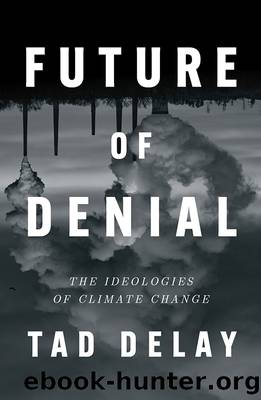Future of Denial: The Ideologies of Climate Change by Tad DeLay

Author:Tad DeLay
Language: eng
Format: epub
Publisher: Verso
Published: 2024-02-23T00:00:00+00:00
Climate Economics
I have so far been fully deferential to IPCC analyses, but climate economics has deep uncertainties. Neoclassical economics is an orthodox theology with priests, after all. Economic categories, like all social sciences, are âforms of expression, manifestations of existence, and frequently but one-sided aspects of this subject,â as Marx put it, and they correspond to a definite form of society, in this case capitalist society. We donât have to like discount rates, externalities, or âoptimal warming,â but we should familiarize ourselves with the masterâs tools.
Integrated assessment models (IAMs) are used to assess human behavioral impacts on the nature. As the name suggests, they integrate climate and non-climate models. Simple IAMs can be run on spreadsheets gauging monetary costs and benefits for emissions levels, while more complex IAMs account for technological changes, land-use changes, and policy options.21 IAM modelers are heterogeneous in discipline, not all economists, and IAM research groups submit scenarios to the IPCC for analysis. Itâs now a large community but wasnât always so. Simple IAMs, including one still cited in IPCC reports, descend genealogically from a modeler whoâs worked these problems for decades, since long before the implications were clear to economists.
In 2018, William Nordhaus won the fake Nobel Prize that bankers created to legitimate what they do, for his work integrating climate models and economics. While Iâm generally skeptical of IAMs, he deserves credit for tackling a difficult problem early. How does one integrate devastating âexternalitiesâ into economic models for the future? His pioneering IAM Dynamic Integrated Climate-Economy (DICE) tackles a question of policy: How do you price a commodity thatâs useful now but destructive later?
Externalities are non-market outcomes of market activities (Nordhaus uses the term âspilloverâ). âIf you poison the groundwater fertilizing your crops, but donât pay the costs created for everyone else, then losses due to poisoned groundwater are not reflected in the price of the farmerâs produce,â explained Geoff Mann on the problem of externalities. âThis misaligns market incentives, over-rewarding destructive behaviour.â22 Remember how fossil fuel subsidies arenât cash payments but rather the externalities for which corporations do not pay? The market underprices things constantly, because it treats the world outside of the narrow sliver of the market as an externality.
Nordhausâs model tries to internalize the externalities, most commonly through a carbon tax. Remember the IPCC recommends a tax of $135 to $6,050 per tonne of carbon dioxide by 2030, raising the price to as much as $30,100 per tonne by 2100.23 But only a few dozen nations implement carbon taxes, and the two with a carbon tax plus dividend paid to citizens, Canada and Switzerland, impose a smaller tax ($30 and $105 per tonne). To correct for spillover and account for the social cost of carbon, DICE recommends a price of about $45, far below what the IPCC recommends.
Skeptical though I may be, we shouldnât discount certain complex IAMs as important research tools. I use an IAM called Global Change Analysis Model (GCAM), one of the primary IAMs used by the research community to study shared socioeconomic pathways.
Download
This site does not store any files on its server. We only index and link to content provided by other sites. Please contact the content providers to delete copyright contents if any and email us, we'll remove relevant links or contents immediately.
The Secret History by Donna Tartt(16699)
The Social Justice Warrior Handbook by Lisa De Pasquale(11501)
Thirteen Reasons Why by Jay Asher(7821)
This Is How You Lose Her by Junot Diaz(5813)
Weapons of Math Destruction by Cathy O'Neil(5066)
Zero to One by Peter Thiel(4854)
The Myth of the Strong Leader by Archie Brown(4804)
Promise Me, Dad by Joe Biden(4466)
Beartown by Fredrik Backman(4455)
How Democracies Die by Steven Levitsky & Daniel Ziblatt(4438)
Stone's Rules by Roger Stone(4432)
The Fire Next Time by James Baldwin(4360)
100 Deadly Skills by Clint Emerson(4101)
A Higher Loyalty: Truth, Lies, and Leadership by James Comey(4049)
Rise and Kill First by Ronen Bergman(4035)
The David Icke Guide to the Global Conspiracy (and how to end it) by David Icke(3904)
The Farm by Tom Rob Smith(3888)
Secrecy World by Jake Bernstein(3798)
The Doomsday Machine by Daniel Ellsberg(3745)
